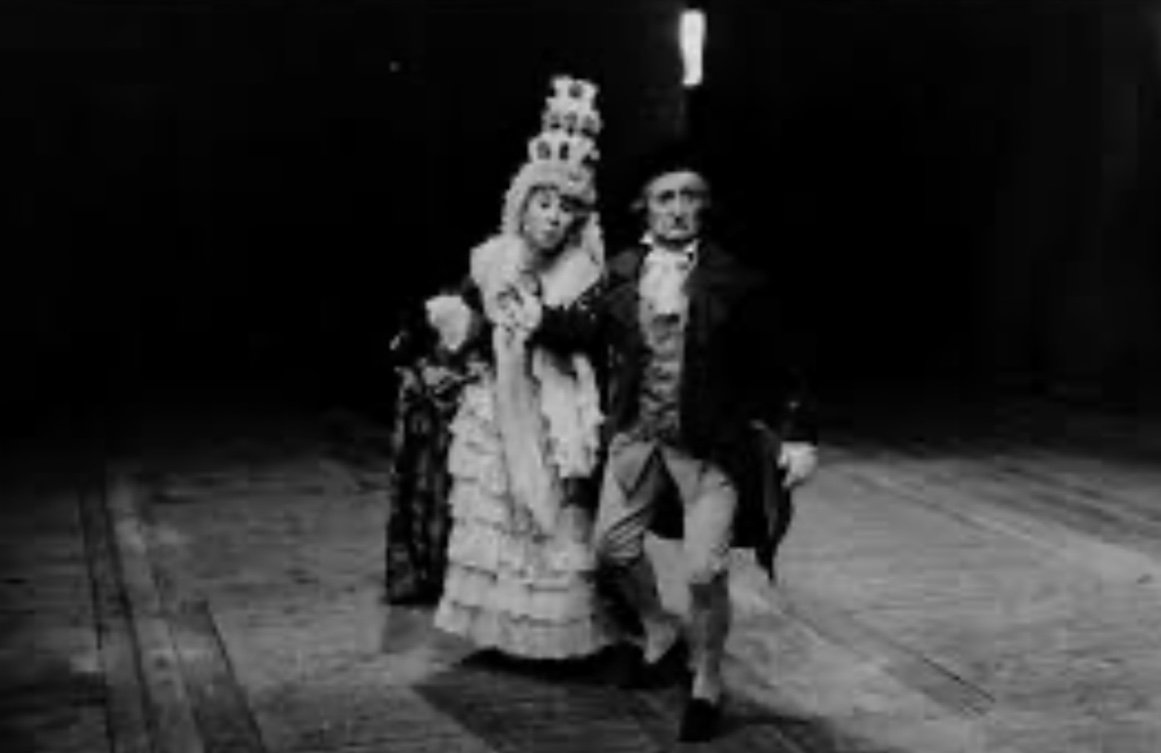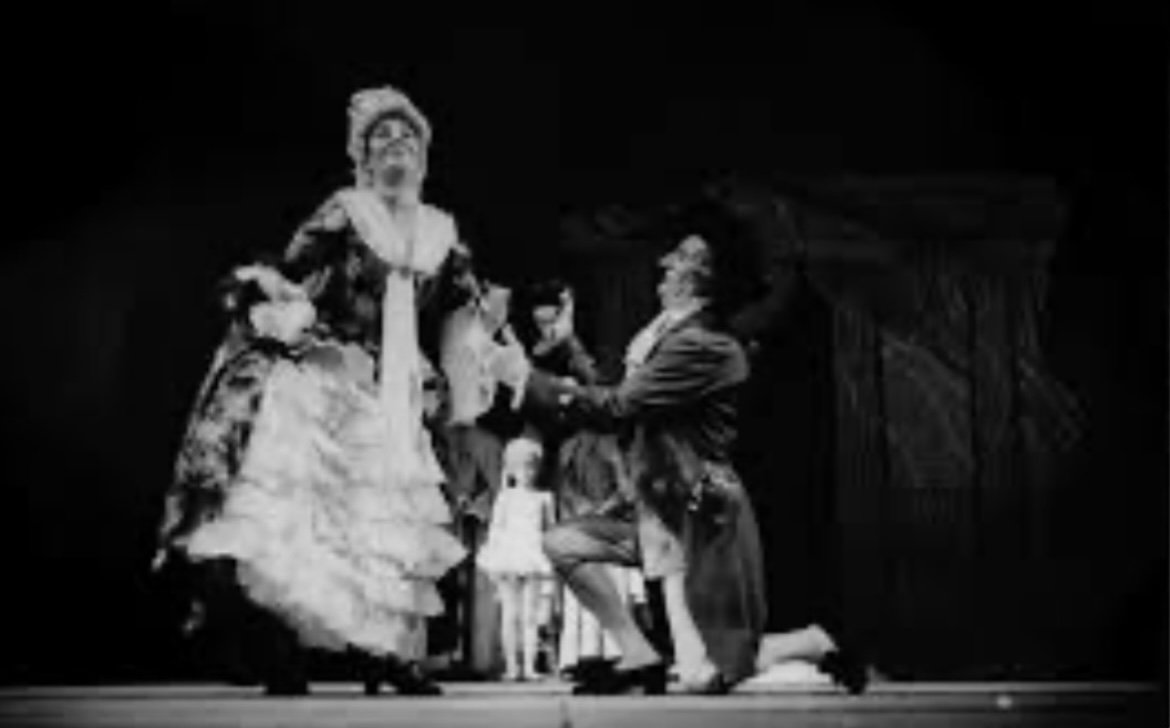A viewing of the world’s oldest ballet in more or less current repertory: Vincenzo Galeotti’s “Amors og Balletmesterens Luner” (“The Whims of Cupid and the Dancing Master”)
This postage stamp (1) all these vivid four photographs (by Roger Wood) all show what has been called the oldest ballet in current repertory: “Amors og Balletmesterens Luner” (“The Whims of Cupid and the Ballet Master”). It was choreographed in 1786 by Vincenzo Galeotti (1733-1816) for the Royal Danish Ballet. Galeotti was the director and ballet master of the Royal Danish Ballet in Copenhagen, Denmark.
The stamp, issued in 1986, commemorated the ballet’s bicentennial. The Royal Danes had brought “Amors og Balletmesterens Luner” to Covent Garden in 1953 (it opened their season then) and to New York’s Metropolitan Opera House in 1956. The four photographs here were taken by Roger Wood in 1947, probably when a number of British dance figures visited Copenhagen. They show (2) Inge Sand as the Amor/Cupid of the title, (3) Gerda Karstens and Ole Palle Hansen as the stiff-legged the Quaker couple, and (4, 5) Elise Landsy and Arne Melchert as the pair of old gentlefolk.
Needless to say, I’ve always hoped to see it, either when the Royal Danish Ballet has toured abroad or on one of my five visits to Copenhagen over forty-four years. I’ve been unlucky in my timing, however. While in Denmark recently, I ascertained something of the performance history of “Amors og Balletmesterens Luner” in the last fifty years. In 1973, it was revived in a new production by Hans Brenaa (1910-1988). The critic Clive Barnes, who was visiting Copenhagen in 1963 and who had first seen “The Whims of Cupid” in the 1953 or earlier, praised it in the “New York Times” as a “perfect” production of “a delight”. That production remained in annual repertory till 1977. It was then revived in 1982-1983, in 1986, in 1998-1999, and (for students of the Royal Danish Ballet School) in 2001.
My own first visit to Copenhagen was for the 1979 Bournonville Festival. One recent dance book (“Why Dance Matters”, Mindy Aloff) makes the bizarre claim that “Amors og Balletmesterens Luner” was staged then. I’ve been relieved to find from several Danish scholars and authorities on my recent 2023 visit, as well as from American and British scholars who attended that 1979 festival, that this is tosh. One or more American authorities do have video recordings of “Amors og Balletmesterens Luner”, but I’ve neglected to ask them for a viewing. Fortunately, on this 2023 visit, the Copenhagen dance scholar Knud Arne Jürgensen, kindly showed me his copy of a 1975 film of Galeotti’s ballet. I wish I’d watched it more than once: it’s full of details, some of which I certainly missed.
The overall fun of “Amors og Balletmesterens Luner” lies in its nice appetite for anthropological diversity: it presents a quick suite of different characters who come in couples to pay homage to Amor/Cupid: old aristocrats, Tyroleans, Quakers, Greeks (neoclassically shown), Norwegians, French, Danish - and Africans. Then Amor/Cupid mischievously blindfolds the characters and mixes the couples - briskly - into incongruous couples. The overall tone of the comedy, even the mischief, is fairly gentle. The 1975 video shows a cast of Danish luminaries, including Frank Andersen, Niels Kehlet, Eva Kloborg, and Arne Villumsen.
Still, there are two kinds of problems here: one of historical accuracy, one of anthropological insensitivity. John Martin had already observed in 1956, when John Martin observed in the “New York Times” that “One’s faith <that its choreography had come down in a direct line from the eighteenth-century original> might be stronger if at one point Cupid did not do a little phrase on point, which is not very likely to have happened in 1786.” The ballet’s touches of pointwork (see 42 and 43) suggest that at some point some post-Galeotti figure or figures have reworked the original choreography. Clive Barnes wrote in 1973 that this ballet “certainly has not dated” - but we must wonder if other revisions have affected Galeotti’s original.
I feel this intensely about the ballet’s six African characters. (Martin described them as “cannibals” in 1956. In 1947, Richard Buckle described one of them as a “portly Negress”, a phrase that surely sounded less unkind than it does now.) As seen in this 1975 video, they’re presented in extreme blackface; I can see why, in 1982, I heard British viewers complain that the “Whims of Cupid” blackface treatment of Africans made it more merely dated but unacceptable (though I failed to spot the “cannibal” element). We can assume this is why “The Whims of Cupid” has seldom been revived this century.
What seems obvious to me is that these black characters in “Amors og Balletmesterens Luner” have been anachronistically revised. They dance with jazz hands (splayed fingers): surely a twentieth-century touch, probably added without malice but now insensitive.
I think it’s fair to hope that a sensitive stager can now revive “The Whims of Cupid and the Dancing Master” without pointwork, without blackface, and without jazz hands. Maybe the African section needs extensive alteration; possibly the elements of caricature throughout the ballet needs careful adjustment of tone. But my impression after one viewing is that the comedy of Galeotti’s ballet is worth saving: it seems more affectionate and pro-diversity than such nineteenth-century ballets as “Le Corsaire” and “La Bayadère”. “Bayadère” is based on the racist notion that, when Indian temple dancers die, they go to white ballet heaven; but, though “Amors og Balletmesterens Luner” has fun about people of different cultures swapping partners, it actually doesn’t suggest that any one culture is better than another.
Even though the Royal Danes haven’t revived this “Whims of Cupid” in over twenty years in its entirety, its Quaker Dance was performed by Gudrun Bojesen and her longterm partner Thomas Lund at Bojesen’s farewell performance in 2016. According to one account, “their stoic and stone faced manners <gave> cause too much laughter in the audience.” Here’s hoping all of “Amors og Balletmesterens Luner” returns to the stage before long, with its retouched passages retouched again.
Wednesday 21 June
1: The 1986 Danish stamp commemorating the bicentennial of “Amors og Balletmesterens Luner” (“The Whims of Cupid and the Dancing Master”)
2: Inge Sand as Amor/Cupid in a 1947 revival of “The Whims of Cupid and the Dancing Master” as danced by the Royal Danish Ballet at Covent Garden. Photograph by Roger Wood
3. Gerda Karstens and Ole Palle Hansen as the Quaker Couple in a 1947 revival of “The Whims of Cupid and the Dancing Master” as danced by the Royal Danish Ballet at Covent Garden. Photograph by Roger Wood.
4: Elise Landsy and Arne Melchert as the pair of old gentlefolk in a 1947 revival of “The Whims of Cupid and the Dancing Master” as danced by the Royal Danish Ballet at Covent Garden. Photograph by Roger Wood.




